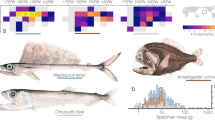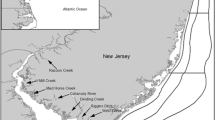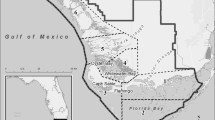Synopsis
We examined the diets of 12 morphologically diverse syngnathid species in shallow seagrass-dominated marine waters of south-western Australia to determine whether they differed among species that varied in body form, size and snout morphology, and in particular whether species with long snouts ingested more mobile prey. Although all species consume mainly small crustaceans, the dietary compositions of these species often vary markedly. We suggest that these differences are related to factors that influence both their foraging capabilities and/or locations. Those species with long snouts (e.g. the common seadragon Phyllopteryx taeniolatus and long-snouted pipefish Vanacampus poecilolaemus) consume far more relatively mobile prey than species with short snouts. Species with short snouts (e.g. the pug-nosed pipefish Pugnaso curtirostris and Macleay’s crested pipefish Histiogamphelus cristatus) mainly consume slow moving prey. Spotted pipefish, Stigmatopora argus, and wide-bodied pipefish, Stigmatopora nigra, restrict their diets to planktonic copepods, probably because their small gape size limits their ability to feed on alternative larger prey. Both the short-snouted seahorse, Hippocampus breviceps, and West Australian seahorse, Hippocampus subelongatus, ingest mainly slow-moving prey, even though the latter species possesses a moderately long snout. This may reflect the fact that seahorses are weak swimmers that anchor themselves to vegetation or the substrate with a strongly prehensile tail and rarely venture into open water to pursue mobile prey. In contrast, the relatively large P. taeniolatus, which resides above, rather than within, the macrophyte canopy, consumes mysids, which aggregate in open water above the seabed. Those pipefishes with characters that imply relatively enhanced mobility, such as well developed caudal fins and non-prehensile tails, are trophically diverse, suggesting that they are able to feed either on the sediment or phytal surfaces or in the water column.
Similar content being viewed by others
References
R.D. Barnes (1974) Invertebrate Zoology W.B. Saunders Philadelphia 870
J.D. Bell M. Harmelin-Vivien (1983) ArticleTitleFish fauna of French Mediterranean Posidonia oceanica seagrass meadows 2 Feeding habits. Tethys 11 1–14
B.A. Bennet G.M. Branch (1990) ArticleTitleRelationships between production and consumption of prey species by resident fish in the Bot, a cool temperate South African estuary Estuar. Coast. Shelf Sci. 31 139–155 Occurrence Handle10.1016/0272-7714(90)90043-Q
B.A. Bergert P.C. Wainwright (1997) ArticleTitleMorphology and kinematics of prey capture in the syngnathid fishes Hippocampus erectus and Syngnathus floridae Mar. Biol. 127 563–570 Occurrence Handle10.1007/s002270050046
G.M. Branch (1966) ArticleTitleContributions to the functional morphology of fishes Part III The feeding mechanism of Syngnathus acus Linnaeus Zoologia Africanensis 2 69–89
I.M. Brook (1977) ArticleTitleTrophic relationships in a seagrass community (Thalassia testudinum), in Card Sound, Florida Fish diets in relation to macrobenthic and cryptic Faunal abundance Trans. Am. Fish. Soc. 106 219–229 Occurrence Handle10.1577/1548-8659(1977)106<219:TRIASC>2.0.CO;2
J.J. Burchmore D.A. Pollard J.D. Bell (1984) ArticleTitleCommunity structure and trophic relationships of the fish fauna of an estuarine Posidonia australis seagrass habitat in Port Hacking, New South Wales Aquat. Bot. 18 71–87 Occurrence Handle10.1016/0304-3770(84)90081-0
M. Campolmi P. Franzoi A. Mazzola (1996) ArticleTitleObservations on pipefish (Syngnathidae) biology in the Stagnone lagoon (west Sicily) Publications Especial de l’ Institut Espana de Oceanografie 21 205–209
K.R. Clarke (1993) ArticleTitleNon-parametric multivariate analyses of changes in community structure Aust. J. Ecol. 18 117–143 Occurrence Handle10.1111/j.1442-9993.1993.tb00438.x
K.R. Clarke R.M. Warwick (1994) Change in Marine Communities: An Approach to Statistical Analysis and Interpretation Plymouth Marine Laboratory Plymouth 144
T.R. Consi P.A. Seifert M.S. Triantafyyllou E.R. Edelman (2001) ArticleTitleThe dorsal fin engine of the seahorse (Hippocampus sp.) J. Morphol. 248 80–97 Occurrence Handle10.1002/jmor.1022 Occurrence Handle1:STN:280:DC%2BD3M7ntVShug%3D%3D Occurrence Handle11268060
C.E. Dawson (1985) Indo-Pacific Pipefishes Gulf Coast Research Laboratory Ocean Springs, Mississipi 230
G.J. Edgar (2000) Australian marine life: The plants and animals of temperate waters, Revised edition Reed New Holland Sydney 544
G.J. Edgar C. Shaw (1995) ArticleTitleThe production and trophic ecology of shallow-water fish assemblages in southern Australia II Diets of fishes and trophic relationships between fishes and benthos at Western Port, Victoria J. Exp. Mar. Biol. Ecol. 194 83–106 Occurrence Handle10.1016/0022-0981(95)00084-4
L.A. Ferry-Graham P.C. Wainwright D.R. Bellwood (2001) ArticleTitlePrey capture in long-jawed butterflyfishes (Chaetodontidae): The functional basis of novel feeding habits J Exp. Mar. Biol. Ecol. 256 167–184 Occurrence Handle10.1016/S0022-0981(00)00312-9
J.G. Field K.R. Clarke R.M. Warwick (1982) ArticleTitleA practical strategy for analysing multispecies distributional patterns Mar. Ecol.-Prog. Ser. 8 37–52 Occurrence Handle10.3354/meps008037
A.J. Flynn D.A. Ritz (1999) ArticleTitleEffect of habitat complexity and predatory style on the capture success of fish feeding on aggregated prey J. Mar. Biol. Assoc. U.K. 79 487–494 Occurrence Handle10.1017/S0025315498000617
P. Franzoi R. Maccagnani R. Rossi V.U. Ceccherelli (1993) ArticleTitleLife cycles and feeding habits of Syngnathus taenionotus and S abaster (Pisces, Syngnathidae) in a brackish bay of the Po River delta (Adriatic Sea) Mar. Ecol. Prog. Ser. 97 71–81 Occurrence Handle10.3354/meps097071
C.J. Fulton D.R. Bellwood P.C. Wainwright (2001) ArticleTitleThe relationship between swimming ability and habitat use in wrasses (Labridae) Mar. Biol. 139 25–33 Occurrence Handle10.1007/s002270100565
S.D. Gerking (1994) Feeding Ecology of Fish Academic Press Sydney. 416 pp
Gomon, M.F., J.C.M. Glover, & R.H. Kuiter. 1994. The Fishes of Australia’s South Coast State Print, Adelaide. 992 pp.
P. Groves (1998) ArticleTitleLeafy sea dragons Scientific American 279 54–59 Occurrence Handle10.1038/scientificamerican1298-84
M.E. Hale (1996) ArticleTitleFunctional morphology of ventral tail bending and prehensile abilities of the seahorse, Hippocampus kuda J. Morphol. 227 51–65 Occurrence Handle10.1002/(SICI)1097-4687(199601)227:1<51::AID-JMOR4>3.0.CO;2-S
L. Hayek M.A. Buzas (1997) Surveying Natural Populations Columbia University Press New York 563
G.R.F. Hicks B.C. Coull (1983) ArticleTitleThe ecology of marine meiobenthic harpacticoid copepods Oceanogr. Mar. Biol. Annu. Rev. 21 67–175
R.K. Howard J.D. Koehn (1985) ArticleTitlePopulation dynamics and feeding ecology of pipefish (Syngnathidae) associated with eelgrass beds of Western Port, Victoria Aust. J. Mar. Freshwater Res. 36 361–370 Occurrence Handle10.1071/MF9850361
S. Huh C.L. Kitting (1985) ArticleTitleTrophic relationships among concentrated populations of small fishes in seagrass meadows J. Exp. Mar. Biol. Ecol. 92 29–43 Occurrence Handle10.1016/0022-0981(85)90020-6
G.A. Hyndes M.E. Platell I.C. Potter (1997) ArticleTitleRelationships between diet and body size, mouth morphology, habitat and movements of six sillaginid species in coastal waters: implications for resource partitioning Mar. Biol. 128 585–598 Occurrence Handle10.1007/s002270050125
G.A. Hyndes A.J. Kendrick L.D. MacArthur E. Stewart (2003) ArticleTitleDifferences in species- and size-composition of fish assemblages in three distinct seagrass habitats with differing structural complexity Mar. Biol. 142 1195–1206
E.J. Hyslop (1980) ArticleTitleStomach contents analysis–a review of methods and their application J. Fish Biol. 17 411–429 Occurrence Handle10.1111/j.1095-8649.1980.tb02775.x
P.L. James K.L. Heck (1994) ArticleTitleThe effects of habitat complexity and light intensity on ambush predation within a simulated seagrass habitat J. Exp. Mar. Biol. Ecol. 176 187–200 Occurrence Handle10.1016/0022-0981(94)90184-8
G.P. Jenkins C.R. Sutherland (1997) ArticleTitleThe influence of habitat structure on nearshore fish assemblages in a southern Australian embayment: Colonisation and turnover rate of fishes associated with artificial macrophyte beds of varying physical structure J. Exp. Mar. Biol. Ecol. 218 103–125 Occurrence Handle10.1016/S0022-0981(97)00071-3
P. Jernakoff A. Brearley J. Nielsen (1996) ArticleTitleFactors affecting grazer–epiphyte interactions in temperate seagrass meadows Oceanogr. Mar. Biol. Annu. Rev. 34 109–162
A. Keast D. Webb (1966) ArticleTitleMouth and body form relative to feeding ecology in the fish fauna of a small lake, Lake Opinicon, Ontario J. Fish. Res. Board Canada 23 1845–1874
A.J. Kendrick G.A. Hyndes (2003) ArticleTitlePatterns in the abundance and size-distribution of syngnathid fishes among habitats in a seagrass-dominated marine environment Estuar. Coast. Shelf Sci. 57 631–640 Occurrence Handle10.1016/S0272-7714(02)00402-X
D.W. Klumpp R.K. Howard D.A. Pollard (1989) Trophodynamics and nutritional ecology of seagrass communities A.W.D. Larkum A.J. McComb S.A. Shepherd (Eds) Biology of Seagrasses, Aquatic Plant Studies 2 Elsevier Amsterdam 394–457
R. Kuiter (2000) Seahorses, Pipefish and Their Relatives TMC Publishing Chorleywood 240
R.J. Livingston (1982) ArticleTitleTrophic organisation of fishes in a coastal seagrass system Mar. Ecol. Prog. Ser. 7 1–12 Occurrence Handle10.3354/meps007001
S. Lourie A.C.J. Vincent H. Hall (1999) Seahorses An Identification Guide to the World’s Species and Their Conservation Project Seahorse London 214
K.L. Main (1987) ArticleTitlePredator avoidance in seagrass meadows: prey behaviour, microhabitat selection, and cryptic colouration Ecology 68 170–180 Occurrence Handle10.2307/1938817
J. Mauchline (1980) ArticleTitleThe biology of mysids and euphausiids Adv Mar Biol 18 1–677
J. Mauchline (1998) ArticleTitleThe biology of calanoid copepods Adv Mar Biol 33 1–707 Occurrence Handle10.1016/S0065-2881(08)60234-5
P.J. Motta K.B. Clifton P. Hernandez B.T. Eggold S.D. Giordano R. Wilcox (1995) ArticleTitleFeeding relationships among nine species of seagrass fishes of Tampa Bay, Florida Bull. Mar. Sci. 56 185–200
M. Muller J.W.M. Osse (1984) ArticleTitleHydrodynamics of suction feeding in fish Trans. Zool. Soc. Lond. 37 51–135
M.E. Platell I.C. Potter (1999) ArticleTitlePartitioning of habitat and prey by abundant and similar sized species of the Triglidae and Pempherididae (Teleostei) in coastal waters Estuar. Coast. Shelf Sci. 48 235–252 Occurrence Handle10.1006/ecss.1998.0419
M.E. Platell I.C. Potter K.R. Clarke (1998) ArticleTitleDo the habitats, mouth morphology and diets of the mullids Upenichthys stotti and U lineatus in coastal waters of south-western Australia differ? J. Fish Biol. 52 398–418
G.P. Quinn M.J. Keough (2002) Experimental design and data analysis for biologists Cambridge University Press Cambridge 556
D.A. Ritz (2000) ArticleTitleIs social aggregation in aquatic crustaceans a strategy to conserve energy Can. J. Fish. Aquat. Sci. 57 (Suppl. 3) 59–67 Occurrence Handle10.1139/cjfas-57-S3-59
D.A. Ritz J.E. Osborn A.E.J. Ocken (1997) ArticleTitleInfluence of food and predatory attack on mysid swarm dynamics J. Mar. Biol. Assoc. U.K. 7 31–42
C.H. Ryer (1988) ArticleTitlePipefish foraging: Effects of fish size, prey size and altered habitat complexity Mar. Ecol. Prog. Ser. 48 37–45 Occurrence Handle10.3354/meps048037
C.H. Ryer R.J. Orth (1987) ArticleTitleFeeding ecology of the northern pipefish, Syngnathus fuscus, in a seagrass community of the lower Chesapeake Bay Estuaries 10 330–336 Occurrence Handle10.2307/1351891
K.V. Singarajah (1969) ArticleTitleEscape reactions of zooplankton: The avoidance of a pursuing siphon tube J. Exp. Mar. Biol. Ecol. 3 171–178 Occurrence Handle10.1016/0022-0981(69)90015-X
A.S. Steffe M. Westoby J.D. Bell (1989) ArticleTitleHabitat selection and diet in two species of pipefish from seagrass: Sex differences Mar. Ecol. Prog. Ser. 55 23–30 Occurrence Handle10.3354/meps055023
R.L. Teixeira J.A. Musick (1995) ArticleTitleTrophic ecology of two congeneric pipefishes (Syngnathidae) of the lower York River, Virginia Environ. Biol. Fish. 43 295–309 Occurrence Handle10.1007/BF00005862
K. Tipton S.S. Bell (1988) ArticleTitleForaging patterns of two syngnathid fishes: Importance of harpacticoid copepods Mar. Ecol. Prog. Ser. 47 31–43 Occurrence Handle10.3354/meps047031
J. Titelman (2001) ArticleTitleSwimming and escape behaviour of copepod nauplii: Implications for predator-prey interactions among copepods Mar. Ecol. Prog. Ser. 203 203–213 Occurrence Handle10.3354/meps213203
P.C. Wainwright (1988) ArticleTitleMorphology and ecology: Functional basis of feeding constraints in Caribbean labrid fishes Ecology 69 635–645 Occurrence Handle10.2307/1941012
P.C. Wainwright B.A. Richard (1995) ArticleTitlePredicting patterns of prey use from morphology of fishes Environ. Biol. Fish. 44 97–113 Occurrence Handle10.1007/BF00005909
E.E. Werner D.J. Hall (1974) ArticleTitleOptimal foraging and the size selection of prey by the bluegill sunfish (Lepomis macrochirus) Ecology 55 1042–1052 Occurrence Handle10.2307/1940354
C.M. Woods (2002) ArticleTitleNatural diet of the seahorse Hippocampus abdominalis New Zealand J. Mar. Freshwater Res. 36 655–660 Occurrence Handle10.1080/00288330.2002.9517121
Author information
Authors and Affiliations
Corresponding author
Rights and permissions
About this article
Cite this article
Kendrick, A.J., Hyndes, G.A. Variations in the dietary compositions of morphologically diverse syngnathid fishes. Environ Biol Fish 72, 415–427 (2005). https://doi.org/10.1007/s10641-004-2597-y
Received:
Accepted:
Issue Date:
DOI: https://doi.org/10.1007/s10641-004-2597-y




